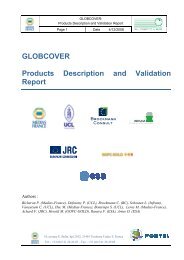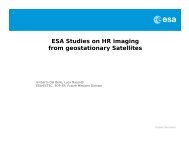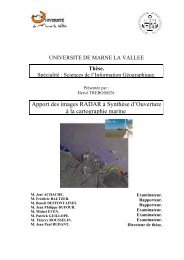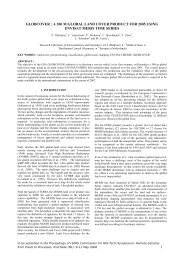Medspiration â System Requirements Document - Data User Element
Medspiration â System Requirements Document - Data User Element
Medspiration â System Requirements Document - Data User Element
You also want an ePaper? Increase the reach of your titles
YUMPU automatically turns print PDFs into web optimized ePapers that Google loves.
<strong>Medspiration</strong> MED-SOC-RS-001_1<br />
<strong>System</strong> <strong>Requirements</strong> <strong>Document</strong> Issue F<br />
Page Table, fig. Reference ID Text from reference documents<br />
SR entry<br />
60 Figure<br />
WP2-188<br />
Functional breakdown diagram of data processing steps to produce L2P data records for microwave satellite SST<br />
NASR<br />
2.2.2.1<br />
data files.<br />
60 WP-ID2.2.2.2 Test for possible sidelobe contamination<br />
60 WP2-189 Microwave SST observations within about 50 to 100 km from land and sea ice are affected by the warm emission of land<br />
NASR<br />
and ice entering the antenna side-lobes. The effect varies by region and season (e.g., in monsoon climates where more<br />
contamination is expected in wet ground conditions) and is difficult to quantify without having access to engineering data<br />
provided by the satellite sensor.<br />
60 WP2-190 It cannot be quantified using buoy match-ups in the coastal zone. NASR<br />
60 WP2-191 Instead, global reference maps identifying regions with persistent sidelobe contamination will be generated by Remote<br />
NASR<br />
Sensing <strong>System</strong>s to provide an estimate the retrieval error in coastal zones and near sea ice margins.<br />
60 WP2-192 The geolocation of each pixel will be used to look up possible contamination from the reference map. NASR<br />
61 WP2-193 Since the effect is different for the 10.7 GHz and 6.9 GHz retrievals, it must be calculated separately for TMI and AMSR-E<br />
NASR<br />
radiometers. We will approach this problem in two ways. Initially, TMI will be collocated with VIRS infrared SSTs while<br />
AMSR-E will be collocated with MODIS SST retrievals. The bias and variability in the STD will be calculated as the STD as<br />
a function of geographic location minus the minimum STD as a function of geographic location. This may be done using<br />
only retrievals within 200 km of land or ice or it may be done globally. There are several issues with this methodology that<br />
should be considered. There will be some overlap with dependencies on SST and wind speed. If the check is only used<br />
close to land, it will ignore possible side-lobe effects near frontal features, but if it is used globally, increased variability from<br />
the IR sensors due to water vapour or stray light will be included. It is expected that further work will be required to<br />
establish the optimum configuration of sidelobe contamination maps.<br />
61 The GDS specifies the following rule:<br />
61 Rule WP2-194 · Rule 2.2.2.2a: If a pixel is located within an area of known sidelobe contamination as defined by sensor specific CFD.0110<br />
© 2004 SOC Page 152 of 193








